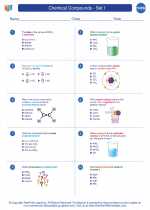Chemical Compounds - Set I -> chemical equation
Chemical Equations
A chemical equation is a concise representation of a chemical reaction using the symbols and formulas of the reactants and products. It provides valuable information about the substances involved in a reaction and the relative quantities of each substance.
Parts of a Chemical Equation
A chemical equation consists of the following components:
- Reactants: These are the substances that participate in the chemical reaction and are written on the left side of the arrow.
- Products: These are the new substances formed as a result of the reaction and are written on the right side of the arrow.
- Arrow symbol (→): This symbol separates the reactants from the products, indicating the direction of the reaction.
- Coefficients: These represent the relative amounts of each substance involved in the reaction. They are placed in front of the chemical formulas to balance the equation.
- Chemical Formulas: These are the symbolic representations of the reactants and products, indicating the types and numbers of atoms or ions present in each substance.
Balancing Chemical Equations
Balancing a chemical equation is essential to ensure that the law of conservation of mass is obeyed. This law states that matter cannot be created or destroyed in a chemical reaction, so the total mass of the reactants must be equal to the total mass of the products.
To balance a chemical equation, follow these steps:
- Write down the unbalanced equation with the correct chemical formulas for the reactants and products.
- Count the number of each type of atom on both sides of the equation.
- Add coefficients to the chemical formulas as needed to balance the number of atoms on both sides of the equation.
- Recount the number of atoms to ensure that the equation is balanced.
Study Guide
When studying chemical equations, consider the following key points:
- Understanding Reactants and Products: Be able to identify the reactants and products in a given chemical equation.
- Interpreting Coefficients: Understand the significance of coefficients in balancing chemical equations and representing the relative amounts of substances involved.
- Practice Balancing Equations: Work on balancing various chemical equations to reinforce the concept and develop proficiency.
- Conservation of Mass: Recognize the importance of balancing equations to uphold the law of conservation of mass.
- Chemical Formulas: Familiarize yourself with the chemical formulas of common substances and their properties.
By mastering the concept of chemical equations and their components, you will be able to analyze and predict the outcomes of chemical reactions with confidence.
[Chemical Equation] Related Worksheets and Study Guides:
.◂Chemistry Worksheets and Study Guides High School. Chemical Compounds - Set I

 Worksheet/Answer key
Worksheet/Answer key
 Worksheet/Answer key
Worksheet/Answer key
